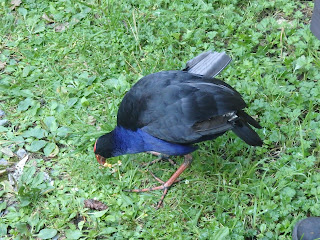As a decade birthday gift for Erick, we signed up for "Exploring Australia and New Zealand," a University of Michigan Alumni tour coordinated by Odysseys International. This post covers our cruise on Milford Sound and a day of adventure in Queenstown.
(You can click on a photo to see a larger version.).
Our special Leap Day continued with a lunch cruise on Milford Sound: Milford is the only one of 14 fiords in Fiordland accessible by road. The fiords are still as explorers found them in the 1800’s. Two permanent and many temporary falls are visible in the fiord. Seals like to sun on the rocks. Mitre Peak is a prominent landmark.
 |
| Mitre Peak - like a bishop's mitre |
Fiords are formed by rivers. Recent rain creates temporary waterfalls and makes the water look brown in the part of the fiord farthest from the sea.
 |
| Homer Tunnel |
 |
| Road leading to and from the tunnel - many switchbacks |
We returned to Queenstown at sunset, passing sheep, cattle and deer stations on the return trip.
 |
Yes, they farm deer for venison in New Zealand.
I had some at the restaurant Roaring Meg's in Queenstown. |
 |
| Back at our hotel |
Day18:
An “on your own” day in Queenstown where there are more activities than one could fit into a month.
We chose a jet boat ride on the Dart River for our morning excursion.
The van trip to the Dart River jet boat center in Glenorchy took us along Lake Wakapitu for one of New Zealand’s most scenic drives.
 |
| The road along the lake |
We traveled from the Dart River jet boat office in Glenorchy by van over parts of the riverbed to the launch point. Jet boats can travel on as little as 4 inches of water and are maneuvered at high speed through the channels of braided rivers like the Dart. We had several stops for photos, and were treated to a number of 360 turns – just for the fun of it.
 |
| Across the dry river bed we go |
 |
| Our jet boat pilot |
 |
| A boat holds 14 plus the pilot |
At various spots the pilot stopped so we could take photos. I didn't even try to take them when we were traveling at 75 mph.
Back in Glenorchy & the return trio to Queenstown:
 |
| In the jet boat office in Glenorchy, a greenstone boulder in a carved holder |
Upon returning to Queenstown, and after some lunch and a rest, Erick decided to sign up for a parasailing adventure from the cliffs over Queenstown.
One rides with an experienced guide who pilots the parasail for a 20-minute ride.
 |
| Our hotel in Queenstown |
 |
| When Erick saw the parasailing, he wanted to do it |
 |
| Erick parasailing |
For more, click on this link to the
video of Erick's adventure.
I extended my rest until he returned and we went to dinner at Roaring Megs. We just happened by the place, which turned out to be an award-winning restaurant for its beef and lamb dishes – and soon to be for its venison (farm-raised) as well. Erick ordered lamb; I had venison.
Day 19: Before our flight via Wellington from Queenstown to Rotorua on the North Island, we toured the Kiwi Birdlife Park. Kiwis are nocturnal, so their enclosures are lighted with infrared light that simulates night time so visitors can get a peek at them running around and eating – sniffing out food with their long beaks with the nostrils very close to the end.
Some of the other birds we saw were much easier to get photos of as live specimens.
 |
| Yes, there is a kiwi there in the middle |
























































































No comments:
Post a Comment